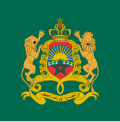List of rulers of Morocco
Appearance
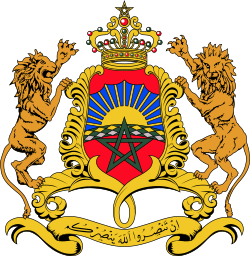 |
|---|
|
|
This is a list of rulers of Morocco since 789. The common and formal titles of these rulers has varied, depending on the time period. Since 1957, the designation King has been used.
The present King of Morocco is Mohammed VI of the Alawi dynasty, since 23 July 1999.[1]
Idrisid dynasty (788–974)
[edit]| Name | Lifespan | Reign start | Reign end | Notes | Family | Image |
|---|---|---|---|---|---|---|
| Idris ben Abdallah (Idris I)
| 745 – 791 | 788 | 791 | First Emir of Morocco | Idrisid | |
| Idris ben Idris (Idris II)
| August 791 – 828 | 803 | 828 | Son of Idris ben Abdallah | Idrisid | |
| Muhammad ben Idris (Muhammad)
| Died 836 | 828 | 836 | Son of Idris ben Idris | Idrisid | |
| Ali ben Muhammad (Ali I)
| 827 – 848 | 836 | 848 | Son of Muhammad ben Idris | Idrisid | 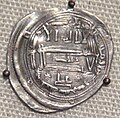 |
| Yahya ben Muhammad (Yahya I)
| 829-864 | 848 | 864 | Son of Muhammad ben Idris | Idrisid | |
| Yahya ben Yahya (Yahya II)
| Died 874 | 864 | 874 | Son of Yahya ben Muhammad | Idrisid | |
| Ali ben Omar (Ali II)
| Died 883 | 874 | 883 | Uncle of Yahya ben Muhammad | Idrisid | |
| Yahya ben al-Qasim (Yahya III)
| Died 904 | 880 | 904 | Cousin of Ali ben Omar | Idrisid | |
| Yahya ben Idris (Yahya IV)
| Died 917 | 904 | 917 | Grandson of Ali ben Omar | Idrisid | |
| Hassan ben Muhammad (Hassan I)
| Died 944 | 925 | 927 | Nephew of Yahya ben al-Qasim | Idrisid | |
Al-Qasim ben Ibrahim
| Died 948 | 937 | 948 | Cousin of Hassan ben Muhammad | Idrisid | |
Ahmad ibn al-Qasim
| Died 954 | 948 | 954 | Son of Al-Qasim ben Ibrahim | Idrisid | |
| Hassan ben al-Qasim (Hassan II)
| Died 985 | 954 | 974 | Brother of Ahmad ibn al-Qasim | Idrisid |
Almoravid dynasty (1040–1147)
[edit]| Name | Lifespan | Reign start | Reign end | Notes | Family | Image |
|---|---|---|---|---|---|---|
| Abdallah ibn Yasin | Died 7 July 1059 | 1040 | 1059 | Founder and First Almoravid Leader of Morocco | Almoravid | |
| Abu Bakr ibn Umar | Died 1087 | 1056 | 1072 | Second Almoravid Leader of Morocco | Almoravid | |
| Yusuf ibn Tashfin | Died 1106 In Marrakesh | 1072 | 1106 | Amir Al-Muslimin | Almoravid | |
| Ali ibn Yusuf | 1084 – 26 January 1143 | 1106 | 1143 | Son of Yusuf Ibn Tashfin | Almoravid | |
| Tashfin ibn Ali | Died 23/25 March 1145 | 1143 | 1145 | Emir of Morocco | Almoravid | |
| Ibrahim ibn Tashfin | Died 1147 | 1146 | 1147 | Seventh Almoravid King of Morocco | Almoravid | |
| Ishaq ibn Ali | Died April 1147 | 1147 | 1147 | Last Almoravid Leader of Morocco | Almoravid |
Almohad dynasty (1121–1269)
[edit]| Name | Lifespan | Reign start | Reign end | Notes | Family | Image |
|---|---|---|---|---|---|---|
| Ibn Tumart | 1080 – 1130 | 1121 | 1139 | First Almohad Leader of Morocco | Almohad | |
| Abd al-Mu'min | 1094 – 1163 | 1133 | 1163 | Member of the Almohad dynasty | Almohad |  |
| Abu Yaqub Yusuf | 1135 – 1184 | 1163 | 1184 | second Almohad Emir | Almohad | |
| Yaqub al-Mansur | 1160 – 23 January 1199 | 1184 | 1199 | third Almohad Caliph | Almohad | |
| Muhammad al-Nasir | Died 1213 | 1199 | 1213 | Fourth Almohad caliph | Almohad | |
| Yusuf II, Almohad caliph | 1203 – 1224 | 1213 | 1224 | son of Muhammad al-Nasir | Almohad | |
| Abd al-Wahid I | Died September 1224 | February | September 1224 | son of the great Almohad conqueror Abu Yaqub Yusuf | Almohad | |
| Abdallah al-Adil | October 4, 1227 | September 1224 | October 4, 1227 | a former governor in al-Andalus | Almohad | |
| Yahya al-Mu'tasim | Died 1236 | 1227 | 1229 | He was a son of Muhammad al-Nasir and brother of Yusuf II, Almohad caliph. | Almohad | |
| Idris al-Ma'mun | Died October 16/17, 1232 | 1229 | 1232 | He was a son of Abu Yusuf Yaqub al-Mansur | Almohad | |
| Abd al-Wahid II | Died December 4, 1242 | 1232 | 1242 | An Almohad rival caliph who reigned from 1232 until his death. | Almohad | |
| Abu al-Hasan as-Said al-Mutadid | Died June 1248 | 1242 | 1248 | He succeeded his brother Abd al-Wahid II in a period in which the Almohads controlled only parts of present-day Morocco | Almohad | |
| Abu Hafs Umar al-Murtada | Died 1266 | 1248 | 1266 | An Almohad caliph who reigned over part of present-day Morocco from 1248 until his death. | Almohad |  |
| Idris al-Wathiq | Died 1269 | 1266 | 1269 | An Almohad caliph who reigned in Marrakesh from 1266 until his death. | Almohad |
Marinid dynasty (1195–1465)
[edit]| Name | Lifespan | Reign start | Reign end | Notes | Family | Image |
|---|---|---|---|---|---|---|
| Abd al-Haqq I | 1147 – 1217 | 1195 | 1217 | First Marinid Leader of Morocco | Marinid | |
| Uthman ibn Abd al-Haqq | 1196 – 1240 | 1217 | 1240 | Sheikh of Morocco | Marinid | |
| Muhammad ibn Abd Al-Haqq | 1202 – 1244 | 1240 | 1244 | Sheikh of Morocco | Marinid | |
| Abu Yahya ibn Abd al-Haqq | Died 1258 | 1244 | 1258 | Emir of Morocco | Marinid | 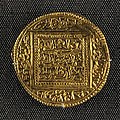 |
| Abu Yusuf Yaqub ibn Abd al-Haqq | 20 March 1286 | 1258 | 1286 | First Marinid Sultan of Morocco | Marinid | |
| Abu Yaqub Yusuf an-Nasr | Died 13 May 1307 | March 1286 | 13 May 1307 | son of Abu Yusuf Yaqub ibn Abd al-Haqq | Marinid | |
| Abu Thabit 'Amir | 1284 – 1308 | May 1307 | July 1308 | Son of Abu Yaqub Yusuf an-Nasr | Marinid | |
| Abu al-Rabi Sulayman | March 1289 – 23 November 1310 | 1308 | 1310 | Son or grandson of Abu Yaqub Yusuf | Marinid | |
| Abu Sa'id Uthman II | December 1276 – August 1331 | November 1310 | August 1331 | Son of Abu Yaqub Yusuf al-Nasr | Marinid | |
| Abu al-Hasan Ali ibn Othman | 1297 – 1351 | August 1331 | 1348 | Son of Abu Sa'id Uthman II | Marinid | |
| Abu Inan Faris | 1329 – 10 January 1358 | 1348 | 1358 | Son of Abu al-Hasan Ali ibn Othman | Marinid | |
| Abu Bakr ibn Faris | Died 1359 | 1358 | 1359 | Sultan of Morocco | Marinid | |
| Ibrahim ibn Ali | 1335 – 1361 | 1359 | 1361 | Sultan of Morocco | Marinid | |
| Tashfin ibn Ali | 1329 – 1362 | 1361 | 1362 | Sultan of Morocco | Marinid | |
| Muhammad II ibn Faris | 1338 – 1366 | 1362 | 1366 | Sultan of Morocco | Marinid | |
| Abu Faris Abd al-Aziz I | 1349 – 1372 | 1366 | 1372 | Sultan of Morocco | Marinid | |
| Muhammad III ibn Abd al-Aziz | 1368 – 1374 | 1372 | 1374 | Son of Abu Faris Abd al-Aziz I of Morocco | Marinid | |
| Abu al-Abbas Ahmad al-Mustansir | Died 1393 | 1374 | 1393 | son of Abu Faris Abd al-Aziz I of Morocco | Marinid | |
| Musa ibn Faris al-Mutawakkil | Died 1386 | 1384 | 1386 | Disabled son of the former Sultan Abu Inan Faris | Marinid | |
| Muhammad ibn Ahmad al-Wathiq | Died 1387 | 1386 | 1387 | Ruled Morocco for only a year | Marinid | |
| Abd al-Aziz II ibn Ahmad II | 1375 – 1396 | 1394 | 1396 | Sultan of Morocco | Marinid | |
| Abdallah ibn Ahmad II | 1378 – 1398 | 1396 | 1398 | Abdul Aziz II succeeded his brother Abu Faris Abdul Aziz II | Marinid | |
| Abu Said Uthman III | 1383 – 21 October 1420 | 19 March 1398 | 21 October 1420 | He succeeded his brother, Abu Amir Abdallah ibn Ahmad. | Marinid | |
| Abd al-Haqq II | 1419 – 14 August 1465 | October 1420 | 14 August 1465 | Last Marinid Ruler of Morocco | Marinid |
Idrisid interlude (1465–1471)
[edit]- Muhammad ibn Ali Idrisi-Joutey (1465–1471)
Wattasid dynasty (1472–1554)
[edit]| Name | Lifespan | Reign start | Reign end | Notes | Family | Image |
|---|---|---|---|---|---|---|
| Abu Abd Allah al-Sheikh Muhammad ibn Yahya | 1472 – 1504 (aged 32) | 1472 | 1504 | First Wattasid Sultan of Morocco | Wattasid | |
| Abu Abd Allah al-Burtuqali Muhammad ibn Muhammad | 1464 – 1536 (aged 72) | 1504 | 1526 | Son of Abu Abd Allah al-Sheikh Muhammad ibn Yahya | Wattasid | |
| Abu al-Abbas Ahmad ibn Muhammad | Died 1549 | 1526 | 1545 | Third Wattasid Sultan of Morocco | Wattasid |  |
| Nasir ad-Din al-Qasri Muhammad ibn Ahmad | Died 1547 | 1545 | 1547 | Fourth Wattasid Sultan of Morocco | Wattasid | |
| Ali Abu Hassun | Died September 1554 | 1549 | 1554 | Fifth Wattasid Sultan Of Morocco | Wattasid |
Saadi dynasty (1544–1659)
[edit]| Name | Lifespan | Reign start | Reign end | Notes | Family | Image |
|---|---|---|---|---|---|---|
Mohammed al-Shaykh
| 1490 – 23 October 1557 (aged 67) | 1544 | 23 October 1557 (Assassinated) | Brother of Ahmed Al-Araj Al-Saadi | Saadi | |
Abdallah al-Ghalib
| 1517 – 22 January 1574 (aged 57) | 1557 | 1574 | Son of Mohammed ash-Sheikh | Saadi | |
Abu Abdallah Mohammed II
| Died 4 August 1578 | 1574 | 1576 (Deposed) | Son of Abdallah al-Ghalib | Saadi | |
Abu Marwan Abd al-Malik I
| Died 4 August 1578 | 1576 | 1578 (Deposed) | Son of Mohammed ash-Sheikh | Saadi |  |
Ahmad al-Mansur
| 1549 – 25 August 1603 (aged 54) | 1578 | 1603 | Son of Mohammed ash-Sheikh | Saadi |  |
| Abu Faris Abdallah Ruled from Marrakesh
| 1564 – 1608 (aged 44) | 1603 | 1608 | Son of Ahmad al-Mansur | Saadi | |
| Mohammed esh-Sheikh el-Mamun Ruled from Fes
| 1566 – 1613 (aged 47) | 1603 | 1613 | Son of Ahmad al-Mansur | Saadi | |
| Zidan el-Nasir Ruled from Marrakesh
| Died September 1627 | 1603 | 1627 | Son of Ahmad al-Mansur | Saadi | |
| Abdallah al-Ghalib II Ruled from Fes
| Died 1623 | 1606 | 1623 (Deposed) | Son of Mohammed esh-Sheikh el-Mamun | Saadi | |
| Abd al-Malik ibn Abdallah Ruled from Fes
| Died 1627 | 1623 | February 1627 (Deposed) | Son of Abdallah al-Ghalib II | Saadi | |
Abu Marwan Abd al-Malik II
| Died 1631 | 1627 | 1631 (Assassinated) | Son of Zidan el-Nasir | Saadi | |
Al Walid bin Zidan
| Died 1636 | 1631 | 1636 (Assassinated) | Son of Zidan el-Nasir | Saadi | |
Mohammed esh-Sheikh es-Seghir
| Died 30 January 1655 | 1636 | 1655 (Assassinated) | Son of Zidan el-Nasir | Saadi | 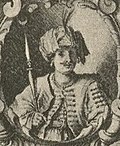 |
Ahmad al-Abbas
| Died 1659 | 1655 | 1659 (Assassinated) | Son of Mohammed esh-Sheikh es-Seghir | Saadi |
Dila'i interlude (1659–1663)
[edit]- Muhammad al-Hajj ad-Dila'i (1659–1663)
Alawi dynasty (1631–present)
[edit]1631–1957: Sultans of Morocco
| Name | Lifespan | Reign start | Reign end | Notes | Family | Image |
|---|---|---|---|---|---|---|
Sharif ibn Ali
| 1589 – 1659 (aged 70) | 1631 | 1636 | First 'Alawi sultan of Morocco | Alawi | |
| Muhammad ibn Sharif Muhammad I
| 1630 – 2 August 1664 (aged 34) | 1636 | 2 August 1664 (Killed in battle) | Son of Mawlay Sharif | Alawi | |
Al-Rashid bin Sharif
| 1631 – 9 April 1672 (aged 41) | 1666 | 9 April 1672 | Son of Mawlay Sharif | Alawi |  |
Ismail bin Sharif
| 1645 – 22 March 1727 (aged 82) | 1672 | 22 March 1727 | Son of Moulay Sharif | Alawi |  |
| Ahmad bin Ismail (1st reign)
| 1677 – 5 March 1729 (aged 52) | 22 March 1727 | March 1728 (deposed) | Son of Ismail Ibn Sharif | Alawi | |
Abd al-Malik bin Ismail
| 1696 – 2 March 1729 (aged 33) | March 1728 | July 1728 (deposed) | Son of Ismail Ibn Sharif | Alawi | |
| Ahmad bin Ismail (2nd reign)
| 1677 – 5 March 1729 (aged 52) | July 1728 | 5 March 1729 | Son of Ismail Ibn Sharif | Alawi | |
| Abdallah bin Ismail (1st reign)
| 1678 – 10 November 1757 (aged 79) | 5 March 1729 | 28 September 1734 (deposed) | Son of Ismail Ibn Sharif | Alawi |  |
Ali bin Ismail
| Died April 1737 | 28 September 1734 | 14 February 1736 (deposed) | Son of Ismail Ibn Sharif | Alawi | |
| Abdallah bin Ismail (2nd reign)
| 1678 – 10 November 1757 (aged 79) | 14 February 1736 | 8 August 1736 (deposed) | Son of Ismail Ibn Sharif | Alawi |  |
| Muhammad bin Ismail (Muhammad II)
| 1694 – 1739 | 8 August 1736 | 18 June 1738 (deposed) | Son of Ismail Ibn Sharif | Alawi | |
| Al-Mostadi bin Ismail (1st reign)
| Died 1759 | 18 June 1738 | February 1740 (deposed) | Son of Ismail Ibn Sharif | 'Alawi | |
| Abdallah bin Ismail (3rd reign)
| 1678 – 10 November 1757 (aged 79) | February 1740 | 13 June 1741 (deposed) | Son of Ismail Ibn Sharif | Alawi |  |
Zin al-Abidin bin Ismail
| 1692 – 1762 (aged 70) | 13 June 1741 | 24 November 1741 (deposed) | Son of Ismail Ibn Sharif | Alawi | |
| Abdallah bin Ismail (4th reign)
| 1678 – 10 November 1757 (aged 79) | 24 November 1741 | 3 February 1742 (deposed) | Son of Ismail Ibn Sharif | Alawi |  |
| Al-Mostadi bin Ismail (2nd reign)
| Died 1759 | 3 February 1742 | May 1743 (deposed) | Son of Ismail Ibn Sharif | Alawi | |
| Abdallah bin Ismail (5th reign)
| 1678 – 10 November 1757 (aged 79) | May 1743 | July 1747 (deposed) | Son of Ismail Ibn Sharif | Alawi |  |
| Al-Mostadi bin Ismail (3rd reign)
| Died 1759 | July 1747 | October 1748 (deposed) | Son of Ismail Ibn Sharif | Alawi | |
| Abdallah bin Ismail (6th reign)
| 1678 – 10 November 1757 (aged 79) | October 1748 | 10 November 1757 | Son of Ismail Ibn Sharif | Alawi |  |
| Muhammad bin Abdallah (Muhammad III)
| 1710 – 9 April 1790 (aged 80) | 10 November 1757 | 9 April 1790 | Son of Abdallah | Alawi | |
Yazid bin Muhammad
| 1750 – 23 February 1792 (aged 42) | 9 April 1790 | 23 February 1792 | Son of Muhmammad bin Abdallah | Alawi | |
Sulayman bin Muhammad
| 1760 – 28 November 1822 (aged 62) | 23 February 1792 | 28 November 1822 | Son of Muhammad bin Abdallah | Alawi |  |
Abd al-Rahman bin Hisham
| 1778 – 24 August 1859 (aged 81) | 28 November 1822 | 24 August 1859 | Nephew of Sulayman bin Muhammad | Alawi |  |
| Muhammad bin Abd al-Rahman (Muhammad IV)
| 1802 – 16 September 1873 (aged 71) | 24 August 1859 | 16 September 1873 | Son of Abd al-Rahman bin Hisham | Alawi |  |
| Hassan bin Mohammed (Hassan I)
| 1836 – 9 June 1894 (aged 58) | 16 September 1873 | 9 June 1894 | Son of Muhammad bin Abd al-Rahman | Alawi |  |
Abd al-Aziz bin Hassan
| 24 February 1878 – 10 June 1943 (aged 65) | 7 June 1894 | 4 January 1908 (deposed) | Son of Hassan bin Muhammad | Alawi |  |
Abd al-Hafid bin Hassan
| 24 February 1876 – 4 April 1937 (aged 61) | 4 January 1908 | 12 August 1912 (abdicated) | Son of Hassan bin Muhammad | Alawi |  |
Yusef bin Hassan
| 1882 – 17 November 1927 (aged 45) | 13 August 1912 | 17 November 1927 | Son of Hassan bin Muhammad | Alawi |  |
| Muhammad bin Yusef (Muhammad V) (1st reign)
| 10 August 1909 – 26 February 1961 (aged 51) | 17 November 1927 | 20 August 1953 (deposed) | Son of Yusef bin Hassan | Alawi |  |
Mohammed bin Arafa
| 1886 – 17 July 1976 (aged 90) | 21 August 1953 | 1 October 1955 (abdicated) | Grandson of Muhammad bin Abd al-Rahman | Alawi |  |
| Muhammad bin Yusef (Muhammad V) (2nd reign)
| 10 August 1909 – 26 February 1961 (aged 51) | 16 November 1955 | 14 August 1957 (proclaimed King of Morocco) | Son of Yusef bin Hassan | Alawi |  |
1957–present: Kings of Morocco
| Name | Lifespan | Reign start | Reign end | Notes | Family | Image |
|---|---|---|---|---|---|---|
| Muhammad bin Yusef (Muhammad V)
| 10 August 1909 – 26 February 1961 (aged 51) | 14 August 1957 | 26 February 1961 | Son of Yusef bin Hassan | Alawi |  |
| Hassan bin Muhammad (Hassan II)
| 9 July 1929 – 23 July 1999 (aged 70) | 26 February 1961 | 23 July 1999 | Son of Muhammad bin Yusef | Alawi |  |
| Muhammad bin Hassan (Muhammad VI)
| 21 August 1963 | 23 July 1999 | Incumbent | Son of Hassan bin Muhammad | Alawi |  |
Timeline
[edit]
Royal standard
[edit]-
Royal standard of Morocco
See also
[edit]References
[edit]- ^ "Mohammed VI takes Moroccan throne". BBC News. 24 July 1999. Archived from the original on 8 July 2004. Retrieved 18 February 2010.

